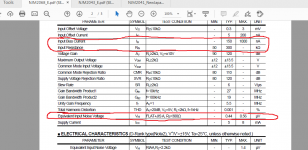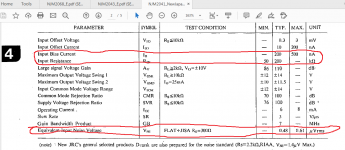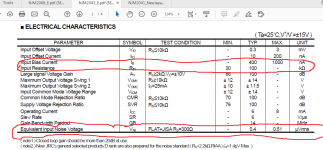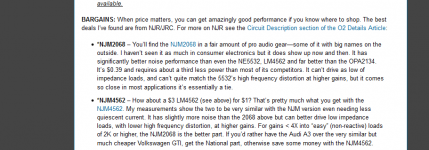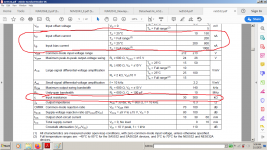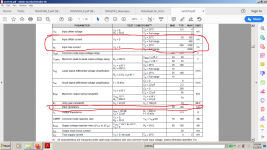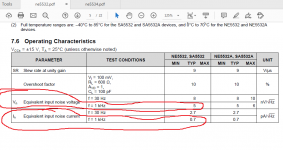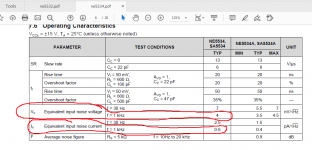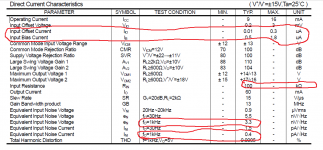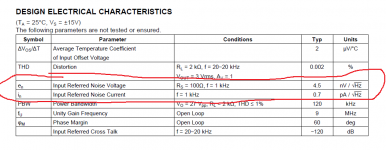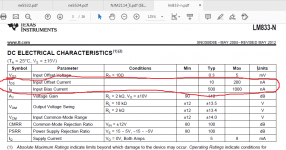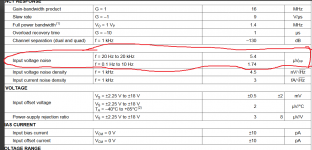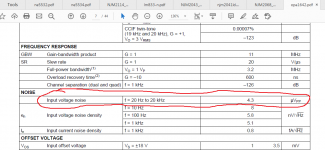They're not really if you saw it at work in recording equipment. Fostex made a name for itself using njm2041(unfortunately extinct), njm2068 and njm2043 competing Tascam ...Tascam tools were more resilient, Fostex was lower noise... There were clear measurements published on O2 headphones amp designer's site about njm2068 used at higher than 4.5X gains(unity gain performance wasn't the Japanese parts preferred game , but these chips were meant to work in low noise high gain preamps...) , then you make some quick check on each op-amp datasheet.You'll see a logic progression 100, 200, 300k ohm input resistance attached to current bias progression with no current offset cancellation vs input noise...How do you figure that? NJM's noise specs are quite an enigma.
So njm2043(Zin=100kohm) compared with njm2041(200k) and njm2068(300k) while ne5534(100kohm input impedance) vs ne5532(300kohm impedance) shows the same pattern, including the higher bias current for the lower Zin and noise, so actually in a higher input impedance circuit ne5532 is lower noise than ne5534...
So paralleling two ne5532 as they are two op amps in one case you get approximately the same noise as ne5534 at the same input impedance ...
NwAvGuy: Op Amp Measurements
Attachments
Last edited:
How can this be?..... so actually in a higher input impedance circuit ne5532 is lower noise than ne5534...
NE5532 voltage noise = 5nV√Hz; current noise = 0.7 pA/√Hz
NE5534 voltage noise = 3.5nV√Hz; current noise = 0.4 pA/√Hz
Above ~ 2-3K Ω, current noise dominates.
First of all i don't see so much dramatic differences in the TI datasheet...How can this be?
NE5532 voltage noise = 5nV√Hz; current noise = 0.7 pA/√Hz
NE5534 voltage noise = 3.5nV√Hz; current noise = 0.4 pA/√Hz
Above ~ 2-3K Ω, current noise dominates.
Then...lower Zin means it won't be able to amplify all the signal that comes from a high Z source at higher gains...so the overall SNR will be lower for ne5534 with a high Z signal source than it s for NE5532.
You have the same problem with the lower noise njm2114 vs LM833 in i/v conversion stages.Just switch lm833 with njm2114 in the same stage with same gain resistor and you'll see that lm833 has clear higher output for the same input.Apparently NJM2114 is lower noise, but also lower output although on papers it looks like the superior part...
Attachments
Last edited:
Yeah, I was referring to the NE5534 A part, which is noticeably quieter. I was able to figure out the difference in noise specs between the 'E.I.N.' number and the noise density number. It's simply the square root of the frequency bandwidth; which for audio (20 Hz to 20K Hz) is ~141. Utilizing this, indeed the NJM parts are quieter! You are correct--- I was surprised.
Where did you find the NJM datasheets that show the noise density as well as THD specs?
As far as input impedance goes, we're talking 'normal' source impedances for AUDIO solid-state circuits (not tubes), which are on the order of <10 K Ω, making the input impedances of >100K Ω quite irrelevant to frequency response.
Where did you find the NJM datasheets that show the noise density as well as THD specs?
As far as input impedance goes, we're talking 'normal' source impedances for AUDIO solid-state circuits (not tubes), which are on the order of <10 K Ω, making the input impedances of >100K Ω quite irrelevant to frequency response.
If you look under the table or the last lines of the tables in the datasheet you also see the RIAA standard noise over the bandwidth as all those op-amps were intended to be used in MM phono preamps which naturally are high Z sources.
https://www.mouser.com/datasheet/2/294/NJM2043_E-364224.pdf
pdf.datasheetcatalog.com/datasheet/newjapanradio/ae04017.pdf
https://www.njr.com/semicon/PDF/NJM2068_E.pdf
https://www.mouser.com/datasheet/2/294/NJM2043_E-364224.pdf
pdf.datasheetcatalog.com/datasheet/newjapanradio/ae04017.pdf
https://www.njr.com/semicon/PDF/NJM2068_E.pdf
did you you try it with a phono input?That noise is the typical noise, not the max one...I had some unpleasant experience with opa1642 in the past...opa1678 cheap, excelent opamp
Attachments
Last edited:
I had some unpleasant experience with opa1642 in the past...
Please explain...
For me it is my main OpAmp for MM-Source.
i had a batch of opa1642 op-amps from Mouser with huge noise...but i tried them on tape head preamps...i used opa2132 which on paper had twice the noise of opa1642 , and opa2132 proved to be lower noise...I have no idea why...Please explain...
For me it is my main OpAmp for MM-Source.
yes but it doesn't matter when they all have the same reference and also show the typical RIAA noise over bandwidth measurement too .I simply explained my reasons for why i think they are lower noise, but i also heard them in real circuits and noise wise they outperform ne5532 in high gain circuits .NWavguy also measured njm2068 ns ne5532(4) on D-scope.You can read what he says in that link i posted right at the beginning of our dispute...Did you notice on the NJM datasheet tables that they are quoting 'JIS-A' weighted noise figures? These are typically 10-11 db better than 'flat' specs; this can be seen in their E.I.N. graphs. A bit o' specsmanship blather here, I'd say.
i had a batch of opa1642 op-amps from Mouser with huge noise...but i tried them on tape head preamps...i used opa2132 which on paper had twice the noise of opa1642 , and opa2132 proved to be lower noise...I have no idea why...
Maybe the wrong opamp for this application...?
I made some Comparison Chart:
Hmmmm.....that is disturbing, and makes NO sense. Was there any oscillation? Was proper power supply bypassing employed? what was the source impedance and level?i had a batch of opa1642 op-amps from Mouser with huge noise...but i tried them on tape head preamps...i used opa2132 which on paper had twice the noise of opa1642 , and opa2132 proved to be lower noise...I have no idea why...
Also, why the OPA2132 instead of the OPA2134?
Because i like OPA2132PHmmmm.....that is disturbing, and makes NO sense. Was there any oscillation? Was proper power supply bypassing employed? what was the source impedance and level?
Also, why the OPA2132 instead of the OPA2134?
https://www.diyaudio.com/forums/analogue-source/21809-replacing-dead-phono-opamp-7.html#post6067203I'm still wondering WHERE you found the NJM datasheets that show the full specs---noise density and THD. I've always steered away from their parts due to skimpy specifications.
You see...i started electronics as a hobby with fixing stuff or building stuff with components found in old abandoned or cheaply sourced electronics equipment ... First i saw them at work, i found the theory behind later, sometimes 10 years later...it happened that the frst professional audio equipment i could get for cheap was Fostex and Nakamichi... but if you want something more european that would be able to talk about the japanese deck's quality look for NAD 6300 schematic...some of the best old Cambridge audio equopment also used NJR parts...but almost all the professional equipment manufacturers used these parts at some point here and there.NE5534 was way less used than these.The same with upc4570 , m5220, m5219, m5218, njm4559(low offset njm4558) and many others ...If you know how to use them you don't need anything better.
Last edited:
Now there's an even darker side in these NJM parts, which is that there's no datasheet at all for the SD parts, l-type op-amps with 9 pins, one for GND, which looks like having even lower noise , more stable and higher power... In the photos you have two Tascam multi-trackers and the last two photos shows the headphones amplifier based on NJM4556SD in Yamaha KX400 cassette player which is found in their high end KX930 and KX1200 players also used in the REC head amp ...YEP, njm4556, the headphones op-amp used in the rec section of a high end cassette player.Better check those schematics too.
You see , i was completely surprised to see that almost nobody talked about M5220, NJM2043 and the SD versions of these op-amps in more than 10 years of diyaudio in like hundreds of pages on OP-amp topics while you find them in some of the best equipment ever made...Go to Tapeheads.net and you'll see hundreds of pages talking about these op-amps!
Well ...they talk about Harrs Semiconductor op-amps too...
You see , i was completely surprised to see that almost nobody talked about M5220, NJM2043 and the SD versions of these op-amps in more than 10 years of diyaudio in like hundreds of pages on OP-amp topics while you find them in some of the best equipment ever made...Go to Tapeheads.net and you'll see hundreds of pages talking about these op-amps!
Well ...they talk about Harrs Semiconductor op-amps too...
Attachments
-
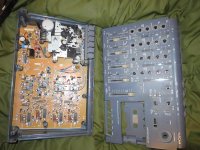 IMG_4494.jpg998.1 KB · Views: 224
IMG_4494.jpg998.1 KB · Views: 224 -
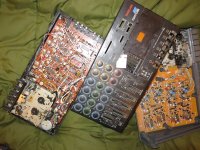 IMG_4495.jpg1 MB · Views: 225
IMG_4495.jpg1 MB · Views: 225 -
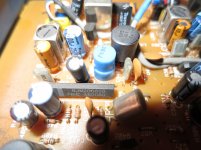 IMG_4506.jpg760.4 KB · Views: 216
IMG_4506.jpg760.4 KB · Views: 216 -
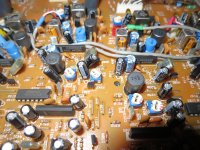 IMG_4517.jpg997.4 KB · Views: 207
IMG_4517.jpg997.4 KB · Views: 207 -
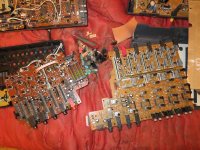 IMG_4522.jpg1 MB · Views: 102
IMG_4522.jpg1 MB · Views: 102 -
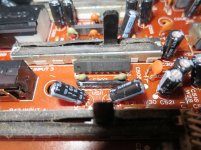 IMG_4527.jpg981.9 KB · Views: 104
IMG_4527.jpg981.9 KB · Views: 104 -
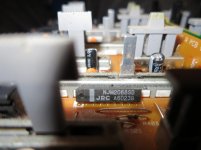 IMG_4537.jpg619.6 KB · Views: 77
IMG_4537.jpg619.6 KB · Views: 77 -
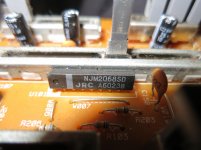 IMG_4538.jpg738.3 KB · Views: 98
IMG_4538.jpg738.3 KB · Views: 98 -
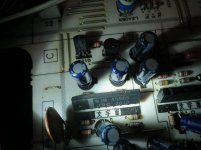 IMG_4546.jpg617.4 KB · Views: 99
IMG_4546.jpg617.4 KB · Views: 99 -
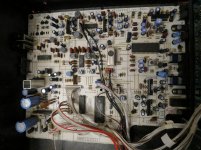 IMG_4547.jpg983.6 KB · Views: 71
IMG_4547.jpg983.6 KB · Views: 71
Last edited:
My very similr comparison chart, different opamps though:
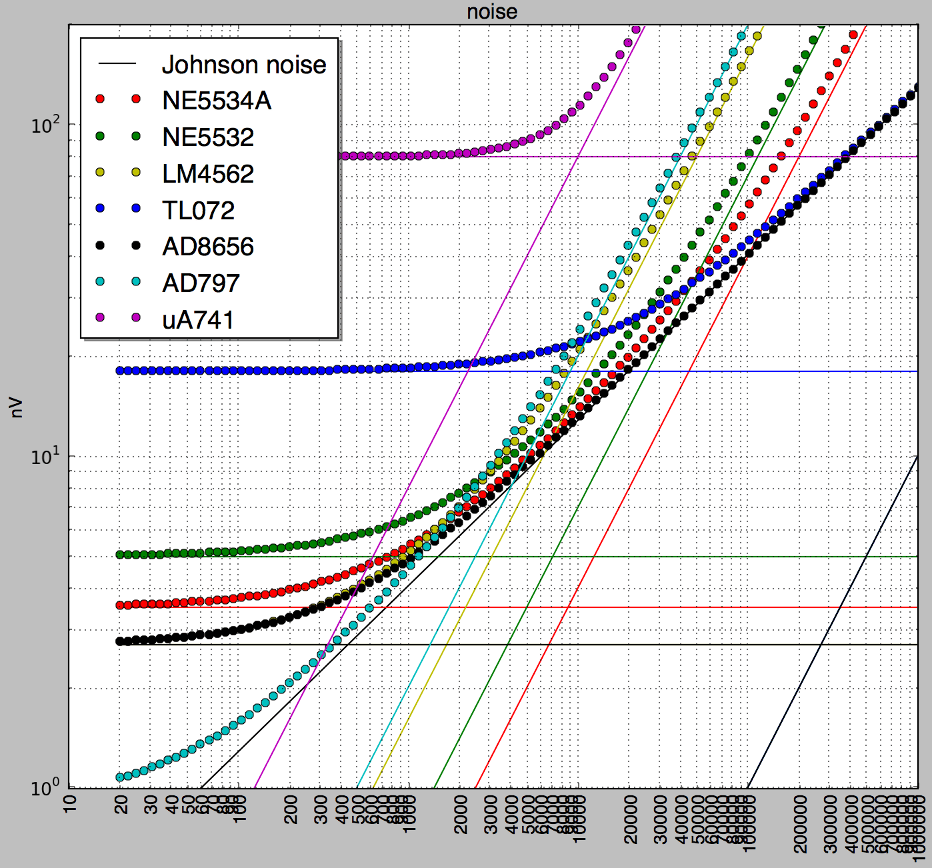
From about 2k to 15k impedance the NE5534A gives pretty much everything a run for its money still... Though its interesting the 5V only CMOS device AD8656 is pretty excellent in this range too (but suffers a high 1/f knee though).
I need to update this with more modern devices. Beware bias current cancellation issues though, datasheet current noise figures can be nonsense for this reason (you almost never have matching input impedances in low noise preamplifier circuits).

From about 2k to 15k impedance the NE5534A gives pretty much everything a run for its money still... Though its interesting the 5V only CMOS device AD8656 is pretty excellent in this range too (but suffers a high 1/f knee though).
I need to update this with more modern devices. Beware bias current cancellation issues though, datasheet current noise figures can be nonsense for this reason (you almost never have matching input impedances in low noise preamplifier circuits).
Last edited:
Maybe old SSL were good enough...i thought old Neve had discrete components...Yeah, those damned old (43 years!) NE5534As are hard to beat for a combination of low voltage noise, low current noise, speed, and distortion. No wonder them old Neve mixing consoles are still the best!
- Status
- This old topic is closed. If you want to reopen this topic, contact a moderator using the "Report Post" button.
- Home
- Source & Line
- Analogue Source
- Replacing Dead Phono Opamp...What to Use??
